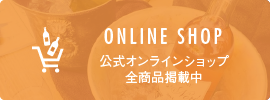『仔豚と南仏ワインの会』ラ・レガラードにて2018/6/10
天然酵母の南仏ビオワインを現地ワイナリーより直輸入するアヴァンが開催する
ローヌ&プロヴァンスワインの魅力を味わうワイン会
5月中旬自由が丘にあるビストロフレンチLa Regaladeラ・レガラードにて『仔豚の南仏ワインの会』
シェフの波多野さんのお人柄があふれるアットホームな雰囲気の会になりましたが、お料理は格式高いフレンチで、南ローヌのシャトーヌフ・デュ・パプ「ヴィエイユ・ジュリアン」のワインと相まって、南仏ではお祝いの際に料理されることも多い乳のみ仔豚のフルコースをいただきました。
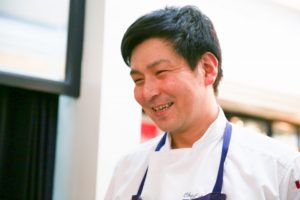
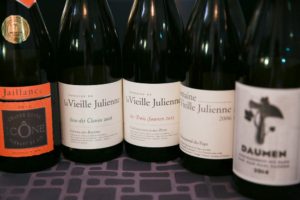
メニュー
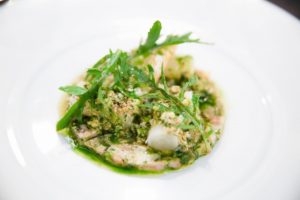
[ 冷前菜] 北海道ホワイトアスパラガスと 乳のみ仔豚のテットドフロマージュの ヴェールソースグリビッシュ

[ 温前菜] 乳のみ仔豚のバロティーヌと レンズ豆のラグー ガトー仕立て アニス風味の赤ワインソース
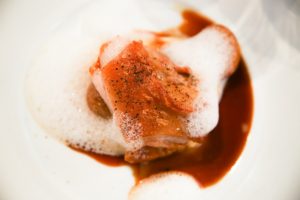
[ メイン料理] 乳のみ仔豚 腿肉のロースト 新ジャガイモのムースリーヌ 新玉葱のソースリヨネーズ
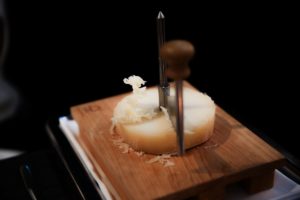

[ チーズ] プティアグール コーヒー&チョコレート
【ワインメニュー】
北ローヌのスパークリング「ジャイアンス」のアイコンラベルICONE BIOで乾杯
クレマン・ド・ディー ブリュットキュベ・イコン ビオ2012 ジャイアンス
ヴィエイユ・ジュリアンの白
グルナッシュブラン、クレレットロゼ、ブールブランのセパージュ
コートデュローヌ ブラン” リューディ クラヴァン”2016 ヴィエイユ ジュリアン
赤ワインはワイナリーからの特別ストック2006年と2012年ビンテージを
シャトーヌフデュパプ レ・トワ・ソース 2012 ヴィエイユ ジュリアン
シャトーヌフデュパプ ルージュ2006 (参考商品)
最後はおまけに
ヴィエイユジュリアンの別名ブランド「ドーメン」のシャトーヌフデュパプも用意しました。
「ヴィエイユ・ジュリアン」ビオディナミ農法、混植、低収量と樹齢100年以上の古木でグルナッシュ主体の優雅なワインを作っています。ワイナリー情報はこちら
心地よい時間を過ごさせていただきました。
ご参加いただいた皆様、誠にありがとうございました。
ローヌラバーなアヴァンだから出来ることを少しづつ今後もお届けしていきます。
2018年5月12日開催
☆次回は6/22(金)南仏ワインと仔牛の会 ご予約受付中です。
Today’s wine: Les Fleurs de Mai 2016, Domaine Georges Vernay2018/6/8
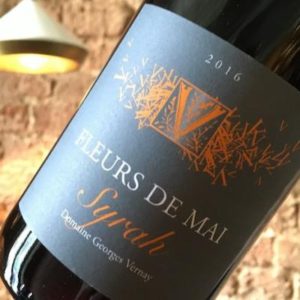
Moving to the reds from this estate and aged in old barrels, the 2016 IGP Fleurs de Mai is a layered, beautiful 100% Syrah from the Northern Rhône that offers lots of blackberries, olives and peppery, even floral characteristics; it has medium-bodied richness, sweet tannin and a great finish. Complex with nice freshness.
Excellent acidic line and tender tannins. Such a long, aromatic finish! Pushes all the Syrah buttons. Pure pleasure.
Direct link to aVin amazon page:
goo.gl/ctLdMG
Origin : Northern Rhône Valley, Collines Rhodaniennes IGP
Les Fleurs de Mai is 100% Syrah grown on the hills just above the Condrieu appellation boundary, within the Collines Rhodaniennes IGP. This is a happy hunting ground for many good-value reds and whites.
SO2: 21mg/l
Viticulture : Organic
Harvest : Manually harvested at maturity, the grapes are then loaded & transported to the cellar in cases.
Vinification: The grapes are first de-stemmed and then placed into temperature controlled stainless steel vats for a fermentation of between 2 to 3 weeks.
Élevage: In oak vats for 8 months.
Vines years average: 50 years old
Vineyards: Mature vines planted on the plateau adjacent
to the Condrieu appellation.
Annual Production: 5,000 bottles
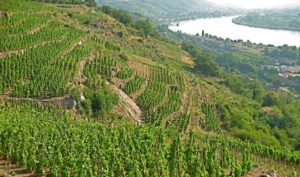
Bottling: without fining or filtration
to eat with: Veal and olive stew
Service Temperature: 16-17° C
Vol: 13,5% vol
To drink: from now until 2021
Bottle Size: 0,75l
Price: ¥2,478
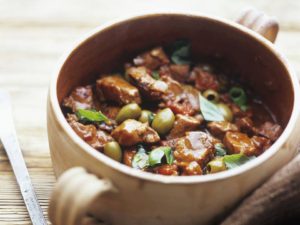
Today’s wine: Ultime Muscat Blanc 2013 Jaillance2018/6/7
aVin’s Amazon direct link: goo.gl/wiY4gQ
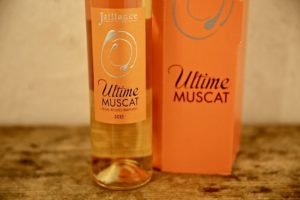
¥ 3,051
Still wine, 50cl 13% vol
IGP Drôme
Hand-picked grapes
Estate bottled
Character-
Color: Beautiful and shiny golden yellow highlights.
Nose: Sweet and fruity Muscat aromas, hint of ginger highlight the subtle notes of candied oranges.
Palate: The acidity balances perfectly with the sweetness to make an harmonious palate, with notes of dried fruit, apricot and currants
Terroir and winemaking-

This wine blooms under the generous sun of the Drôme Valley, sheltered by the powerful foothills of the Vercors, between the Alps and Provence. The grapes of Ultime Muscat have been carefully selected on well-exposed plots where the sun is optimal for the best ripening of the grapes. Thanks to the noble rot, the fungus Botrytis cinerea that develops on the berries, the overripe grape develops all its aromas. The harvest is done in early November at the first cold. Vinification is then done over several months, at low temperature.
Numbered, limited edition.
Food pairing: Ultime Muscat can be enjoyed as an aperitif or with foie gras and gingerbread. It also goes perfectly with a parsley cheese or even a pear pie.

To drink between 3 to 5 years
Serving temperatures: 8°
The Little Prince Dinner2018/6/6
Thank you all for coming to our special dinner event “The Little Prince” with the participation of writer and poet Durian Sukagawa!
Beautiful dishes inspired by this magical tale and created by Penelope Barboza, chef at Ana InterContinental hotel.
A truly magical night!
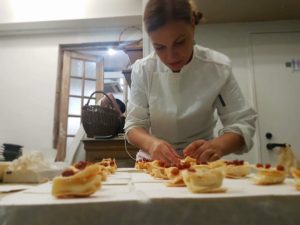
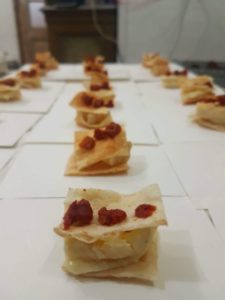
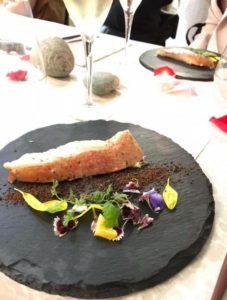


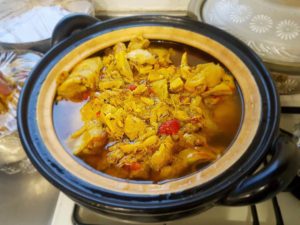
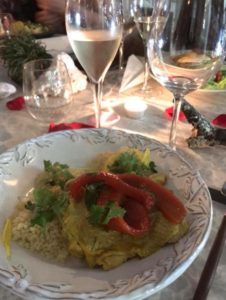
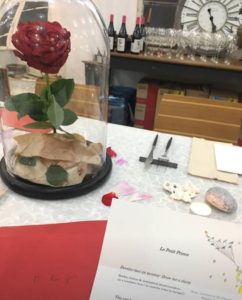

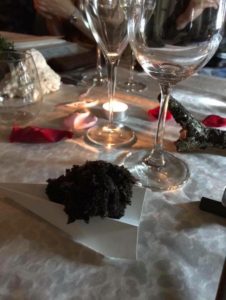



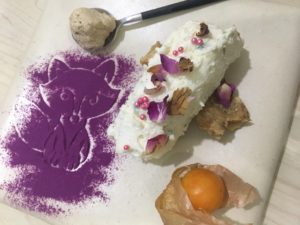
The origin of Syrah-2018/6/4
Syrah is one of the most popular grape varieties in the world. Its wines are typically full-bodied and powerful, with peppery and fruity flavors. Although we all know why we love this grape, the question remains: how did Syrah gain the prominence it currently holds in the international wine scene?
In Australia, Syrah is referred to as Shiraz. This has spurred several myths about its origin. Shiraz is a 4,000+ year-old city in Iran that is known for its wine. Indeed, the world’s oldest sample of wine, dating from a staggering 7,000 years ago, was discovered in clay pots near Shiraz.
The most common myth suggests that the Phocaeans brought Syrah from Shiraz to their colony in Marseille on the southeastern coast of France. From there, it gained popularity and began to move north, to the Rhone region of France. (The myth does not explain how the grape mysteriously disappeared from Marseille shortly afterwards!) Another variation on this myth attributes the grape’s origin to a French knight named Gaspard de Stérimberg, who participated in the crusades in the 1200s. He traveled to Persia (modern day Iran) and returned with the grape in tow. This also seems unlikely, as the crusaders certainly did not travel all the way to Persia!
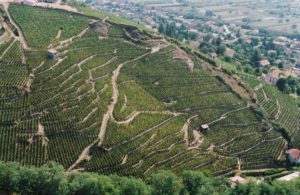
DNA testing by Dr. Carole Meredith, a geneticist who heads the Department of Viticulture and Enology at UC Davis revealed the truth about this beloved grape. It is a cross between two little-known varieties: Dureza and Mondeuse blanche. Dureza is grown exclusively in the Rhone region of France. Although it has been used historically because of its heartiness and high yields, Dureza has fallen out of favor in recent years. By 1988 only a single hectare (2.47 acres) of the grape was left growing. That’s as if the only Syrah on the planet was what we have on the Walla Faces Estate Vineyard! Dureza is also not on the list of allowed wines by the French AOC. Mondeuse blanche is similarly rare. A mere five hectares (12 acres) are left, all in the Savoy region of France.
Because of the parent grape varieties are both from a very small region in southeastern France, we can conclude that Syrah originated there as well, probably in northern Rhone. The exact time of the cross is not clear. Historical documents by the Roman naturalist Pliny the Elder suggest, however, that the cross may have occurred around 20 AD.
Although Syrah is clearly a very old variety, it wasn’t until the 1700s that it began really making a splash. In northeastern Rhone, there was a hill topped with a hermitage (a chapel) built by Gaspard de Stérimberg, the knight of legend. Hermitage wines, red blends made up primarily of Syrah grapes, were consumed worldwide. (They were a favorite of Thomas Jefferson!)
Syrah was brought to Australia by a Scotsman named James Busby in 1831, who collected a wide variety of grapes for the land down under. As a result, he has been dubbed “the father of Australian viticulture”. By the 1860s, Syrah was one of the most popular Australian varietals. Syrah first came to America in the 1970s. It was planted in California by wine-enthusiasts who called themselves the “Rhone rangers”. It finally made its way to Washington state in 1986– almost two thousand years after the grape was first crossed in France.
Syrah is also frequently grown in Switzerland, Chile, Argentina, and South Africa.
Syrah has even gone on to spawn its own offspring! An accidental cross-pollination between Peloursin and Syrah yielded Petite Sirah in a small vineyard in Tullins, France in the mid-1860s.
Now, Syrah has become one of the most popular grapes for wine production. At a staggering 142,600 hectares (352,000 acres) worldwide, it is the seventh most grown grape variety.












